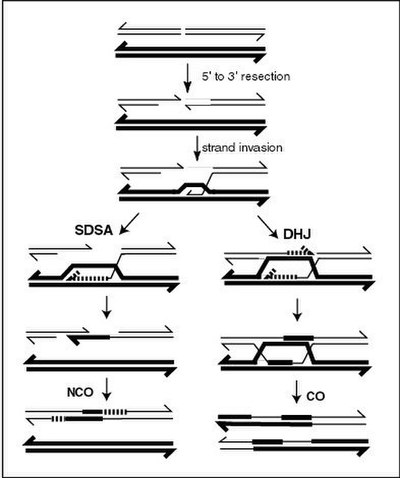Microsatellite
Videos
Page
A microsatellite is a tract of repetitive DNA in which certain DNA motifs are repeated, typically 5–50 times. Microsatellites occur at thousands of locations within an organism's genome. They have a higher mutation rate than other areas of DNA leading to high genetic diversity. Microsatellites are often referred to as short tandem repeats (STRs) by forensic geneticists and in genetic genealogy, or as simple sequence repeats (SSRs) by plant geneticists.

DNA strand slippage during replication of an STR locus. Boxes symbolize repetitive DNA units. Arrows indicate the direction in which a new DNA strand (white boxes) is being replicated from the template strand (black boxes). Three situations during DNA replication are depicted. (a) Replication of the STR locus has proceeded without a mutation. (b) Replication of the STR locus has led to a gain of one unit owing to a loop in the new strand; the aberrant loop is stabilized by flanking units complementary to the opposite strand. (c) Replication of the STR locus has led to a loss of one unit owing to a loop in the template strand. (Forster et al. 2015)

A partial human STR profile obtained using the Applied Biosystems Identifiler kit
DNA
Videos
Page
Deoxyribonucleic acid is a polymer composed of two polynucleotide chains that coil around each other to form a double helix. The polymer carries genetic instructions for the development, functioning, growth and reproduction of all known organisms and many viruses. DNA and ribonucleic acid (RNA) are nucleic acids. Alongside proteins, lipids and complex carbohydrates (polysaccharides), nucleic acids are one of the four major types of macromolecules that are essential for all known forms of life.

Simplified diagram

Impure DNA extracted from an orange

T7 RNA polymerase (blue) producing an mRNA (green) from a DNA template (orange)

A current model of meiotic recombination, initiated by a double-strand break or gap, followed by pairing with an homologous chromosome and strand invasion to initiate the recombinational repair process. Repair of the gap can lead to crossover (CO) or non-crossover (NCO) of the flanking regions. CO recombination is thought to occur by the Double Holliday Junction (DHJ) model, illustrated on the right, above. NCO recombinants are thought to occur primarily by the Synthesis Dependent Strand Annealing (SDSA) model, illustrated on the left, above. Most recombination events appear to be the SDSA type.